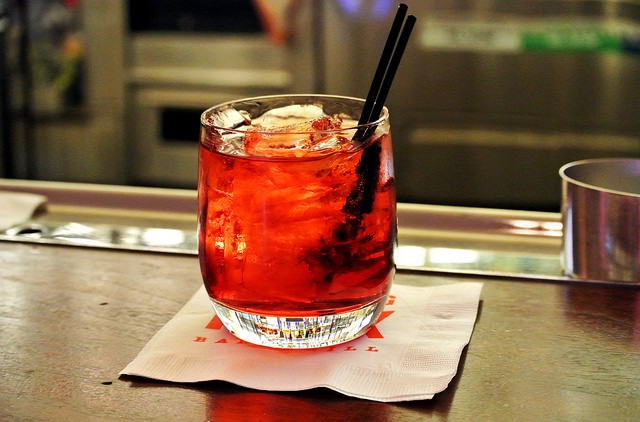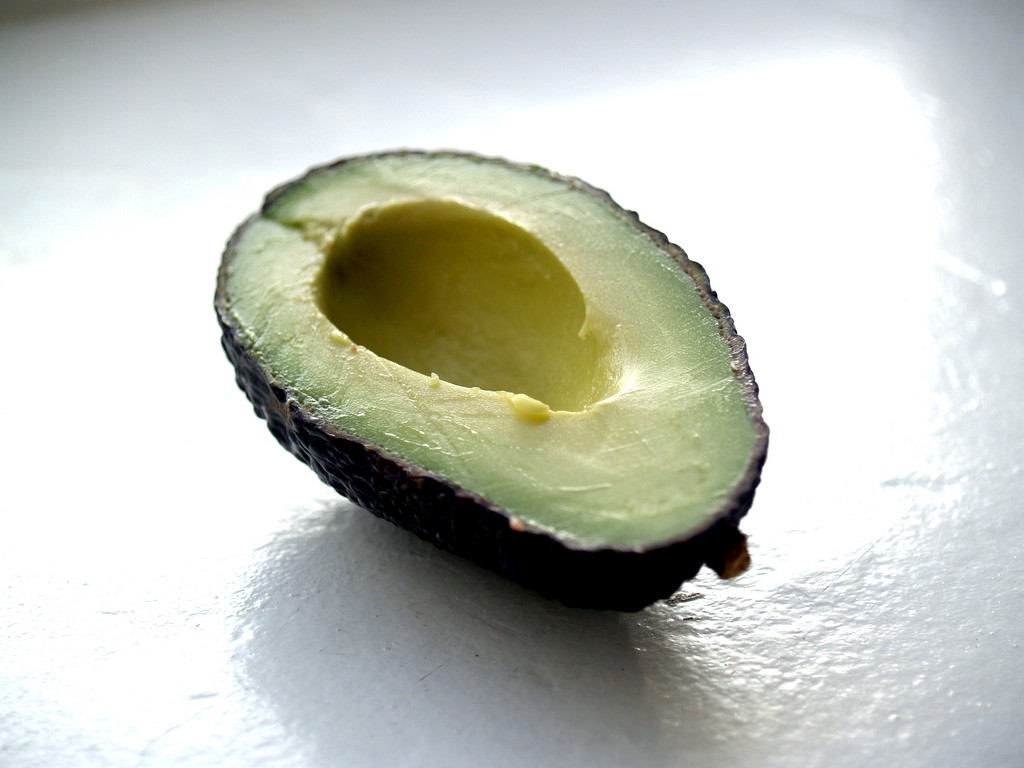Negroni Weak

On Monday, it will once again be Negroni Week. (This is not to be confused with Negroni Season, which is a state of mind, not a time of year.) Hashtag Negroni Week is a recent invention of Imbibe magazine that has since been wholly co-opted by advertising executives and branding consultants employed by Campari America, a subsidiary of the Campari Group, a large corporation that sells, among other things, Wild Turkey whiskey, SKYY Vodka, and its namesake aperitif. Campari is a pink, bitter liqueur, and the signature ingredient in the Negroni, a cocktail that has, in recent years, been adopted by preening gadflys who would like to portray themselves as sophisticated drinkers with a highly discerning palate that allows them to enjoy beverages that are “bitter forward”:
The subtext of the discussion at this mythical world’s-most-awful bar, which might actually exist on the Internet, is that anyone who enjoys negronis has an incredibly distinguished palate which allows them to fully enjoy negronis in a way that most people can’t appreciate. One person told the Times that the negroni is “a sophisticated cocktail, too, for an audience that appreciates the cocktail and the story behind it.” Bon Appetit described the negroni at one point as “a secret handshake, a sign to bartenders that you knew what you liked, and how to order it.” Serious Eats calls it “a serious drink for serious drinkers.” GQ says, “A Negroni, like black coffee or Texas, is an acquired taste.”
Never mind that there are now frozen Negronis.
The most terrible thing about Negroni Week is not that it will encourage these people to come out en masse to drink Negronis and tell you about how they’re drinking Negronis and that you should also drink Negronis, but that Negroni Week, which began as a fairly off-the-cuff charity drive, is now a full-blown marketing event heavily dressed in a booze-soaked garb of philanthropy when it is engineered to do little more than move bottles of Campari.
Bars and restaurants who sign up to participate in Negroni Week agree to “donate $1 (or more) from each one sold to a charity of their choice from June 1–7.” Whichever establishment raises the most money will see an additional ten thousand dollars donated to the charity of its choice by the Campari Group. This is charitable enough on the part of these establishments, especially the ones donating more than the minimum dollar per drink (or foodstuff); most bars and restaurants, especially in cities like New York and San Francisco, survive on slim margins. But ten thousand dollars is a pittance for Campari. Especially when one considers that, according to the New York Times, last year, the Negroni Week campaign cost just under a million dollars.
The net result, according to the Negroni Week website, was “more than $120,000 raised for charities.”
Leaving aside that barely a tenth of the million dollars spent on last year’s campaign actually made it to charities, let’s do some cocktail-napkin math. (Which is hazardous for a number of reasons, not least that participating bars self-report their sales and donations to the organizers of Negroni Week.) Let’s be generous and conservative, and assume that the average amount donated per Negroni was two dollars, or that roughly sixty thousand Negronis were sold by the thirteen hundred bars that have participated in Negroni Week. While proportions (and ingredients) can vary, a classic Negroni contains one ounce of gin, one ounce of sweet vermouth, and one ounce of Campari, meaning that bars might have poured some sixty thousand ounces of Campari down people’s throats. A bottle of Campari is one liter, or 33.8 ounces, so a conservative estimate is that Negroni Week moved at least one thousand, seven hundred and seventy-five bottles of Campari. One bartender in Atlanta told me that the wholesale price per bottle, according to an inventory sheet that is “a few months old,” is twenty-eight dollars; it is markedly cheaper abroad. But given the variabilities of markets and distributor fees, let’s assume that Campari reaps just ten dollars per bottle. That would mean, through Negroni Week, Campari America sold, conservatively, nearly eighteen thousand dollars of Campari, or nearly double what it gave to charity. In other words, the cost of any of the actual charity is being borne entirely by the bars, which have to stock vast quantities of Campari to fulfill the demand artificially inflated by the false premise of good works.
Capitalist enterprises can very occasionally incidentally perform acts of charity. It’s not really charity, though, when the profit-seeking enterprise benefits far more from its charity than any of the causes to which it is supposedly being charitable. Negroni Week is perhaps one of those cases? But like whatever! Go ahead and drink a Negroni next week, if you want. You could even delude yourself into thinking that you are doing a Good Thing. Or you could drink something better — may I suggest something with Gran Classico Bitter, a vastly superior aperitif? — and give some money directly to charity. You know, do you.
Photo by mariobonifacio
Format Remembered
“Thirty years ago this month, Dire Straits released their fifth album, Brothers in Arms. En route to becoming one of the best-selling albums of all time, it revolutionised the music industry. For the first time, an album sold more on compact disc than on vinyl and passed the 1m mark. Three years after the first silver discs had appeared in record shops, Brothers in Arms was the symbolic milestone that marked the true beginning of the CD era.”
— If you are under 30 I bet the only word in this paragraph that makes any sense to you is “vinyl.”
Collarless Shirts Are The New Thing People Are Using To Help Self-Identify As Idiots
You know how, when you are trying to convey amazement at the sheer level of idiocy someone displays on a regular basis, you express wonder at his ability to even dress himself? Well now they’ve made it easier for you.
Bryan Ferry and Todd Terje, "Johnny and Mary"
The sun is shining. Summer is here. We are now at a far enough remove from the endless savagery of winter that you may have forgotten altogether just how truly terrible life can be. It is quite probable that, as you wander about town in comfortable clothing, appreciatively observing all the joys that warm weather summons forth, your mind has tricked you into thinking that from now on things will be okay, that the future is as bright as the skies above, that everything somehow won’t end in failure and heartbreak and doom and recrimination and regret. In which case you should not play the video that Bryan Ferry and Todd Terje have released for their cover of Robert Palmer’s “Johnny and Mary,” which came out last year. It is a song designed to break your heart, if you have a heart which has still yet to break. And on a day like today your heart is probably completely intact. So don’t listen. Let yourself believe that things will wind up okay for you. They won’t, but when the sun is shining it’s awfully easy to pretend that happiness will last, or that you deserve it to. Those of you who have a more realistic appreciation of how life inevitably turns out, however, are encourage to enjoy the elegant sorrow.
Prophet Of Dust Wanders Desert Spreading Word
“’This is prime bighorn sheep territory,’ he says, looking beyond the plastic coyote on his dashboard toward the wide-open vistas. ‘There are no signs of people except for us.’ He points out the dust devils spinning off in the distance. This is his life now.”
Your Contribution to the California Drought and the End Times
by Jamie Lauren Keiles

You’re an ethical consumer, a responsible citizen of the earth. You’ve been known to reduce, reuse, recycle, upcycle, source locally, compost, trade fairly, and offset as needed. You’ve got a Greenpeace sticker on your Sierra Club sticker on the reclaimed cargo bike you use to transport dead nine-volts and used printer cartridges to your local center for reuse. You’re not perfect, but you do your best by committing twenty-three hours of each day to feeling guilty about the environment.
But hey John Muir 2.0, have you ever really stopped to consider your personal contributions to the destruction of our shared global ecosystem?
Let’s start with breakfast. Every eco-warrior needs a good cup of coffee to energize his daily commitment to the cause. On average, the beans for a single cup of coffee require about thirty-four gallons of water to produce1, and throw off massive carbon emissions as they travel over eleven hundred miles from tropical climates to your all-American LEED-certified bungalow. Add to that coffee a splash of almond milk and you’re contributing to a three-and-a-half billion cubic meter water footprint for almond production2, plus the carbon emissions from probably millions of servers running day and night to host and sustain the almond facts sensationalism industry itself. Grill up your daily free-range two-egg omelet and that’s a small kitchen’s worth of land use3, plus nearly half a kilogram of CO2 emissions4, not to mention fossil fuel for the refrigerated eighteen-wheeler that will carry the eggs from the farm to your fridge. Of course you don’t eat meat, but if you did, it’d be worth knowing that bacon farms in North Carolina alone produce fifteen-and-a-half million tons of groundwater-polluting5, greenhouse-gassy pig shit in a single year. That’s just one state, but it’s nothing compared to your daily slices of toast, which will waste twenty-three hundred gallons of water6 by this time next year, or enough water to sustain a human life for twelve years. In 2015, 2.7 billion people on earth will experience water scarcity7, so maybe consider that, Ansel Sadams, next time you’re struggling to decide between whole wheat or rye.
Time for work. Your job at your local 501(c)3 is not going to work itself. Hop on your bike and get riding. That paved bike lane you lobbied for contributes to lowering the water table8 by disrupting natural paths of stormwater runoff and limiting the reabsorption and filtering of rain back into the earth. Those rubber tires on your trusty freecycled Schwinn contribute to a global demand for rubber that’s filled through monoculture9, an unsustainable farming practice which reduces biodiversity, and is endangering animals10 from elephants to bees. Did I mention the almost-certainly unregulated, likely exploitative overseas labor that goes into producing nearly every other component on your bike? Oh right, we’re talking about the environment, not people, stay with me if you can, third-wave Al Gore.
Now it’s lunchtime. You know that guac is extra, but have you ever really considered how much extra? To you it might be just shy of two bucks, but to dying Mother Earth the cost of two tablespoons of guacamole is over twenty gallons of water11. Thinking about upgrading to soy in that latte? Think about this before it’s too late: Monsanto, a multinational agrochemical company, produces over ninety percent of soybeans in the United States12. Monsanto’s patented soybeans are genetically modified to be used in conjunction with glyphosate13, an herbicide that kills weeds and is recognized by the EPA to cause kidney damage, increased breathing rate, and poor reproductive health14. You’re better off ordering good ol’ wholesome cow’s milk instead — milk from American dairy cows that contribute 41.6 million metric tons of methane to the destruction of our atmosphere each year, in farts alone15.
Right about now, you’re probably wondering, “Should I just kill myself16? Allow myself to die of consumption, or perhaps just waste away?””
Hold your cruelty-free horses Sylvia “Sylvan Path” Plath. Before you commit eco-martyrdom, consider the fact that coffins for Americans who kill themselves this year alone will deforest a hundred and fifty-two17 footballs fields of hardwood18. Depending19 on conditions, the average human corpse takes about twelve years to decompose and in that time will release dozens of groundwater-polluting compounds including methane, ammonia, sulphurous acid, and foul-smelling gasses like purscine and cadaverine. This is not to mention the widely-used and carcinogenic20 embalming fluid formaldehyde, which is suspected to make groundwater toxic for human consumption at a rate of only five milligrams per liter21, but is not monitored or regulated by the EPA22, so we can’t be sure! If this concerns you, don’t even begin to think about the water and fertilizer required to maintain the lush and useless death parks known as cemeteries. Between 1990 and 2000, American cities lost fifty-four hundred square miles of greenspace23 — eleven-and-a-half times the land area of LA. But go ahead, fall on your sword made from reclaimed metals. You existed for less than .00003 percent of human history and are certainly deserving of an extravagant burial that will lead the rest of us into end times.
Besides, soon enough, California will break off from the mainland and be swallowed up by the retribution-hungry seas24. Millions will lose their homes — or die even! — and you personally will be to blame. Maybe you should have considered this before you asked to be born.
17. Virginia Sustainable Forestry Initative
19. “’Til Death Do We Pollute”
Photo by cyclonebill
Correction: This post originally miscalculated the amount of land required to produce two eggs that you will eat and promptly shit out. It’s a small studio apartment, not a small farm. We more or less regret the error.
Here's Which Way Your Favorite Gawker Editor Is Voting in the Secret Union Ballot!

This coming Wednesday, June 3rd, all Gawker Media employees — except foreigners, freelancers, two top manager-editors with whom the buck is said to stop, and of course the entire business side, because what would any of them know about how to conduct business or negotiate — will secretly vote on whether to join the WGA East and become a union shop. Because Gawker Media majority owner Nick Denton doesn’t oppose the union at all — it appeals to his trouble-making streak, and he thinks it’ll have interesting ripple effects towards places like Vice — the Gawker office hops directly from “hey let’s have a union” to a majority-rule vote in under six weeks. Pretty wild stuff! It’s the fastest thing anyone has ever done.
Fortunately, since none of us like suspense, Max Read, who is the top editor at Gawker, but who qualifies for this union as an equivalent to a TV-style “showrunner,” if you follow that logic, and I sort of do and sort of don’t, sent around a memo to encourage everyone to post on Gawker how they were planning on secretly voting. He wrote:
I’m hoping the post will be, in the true spirit of Kinja®, a open forum for discussion, not a rolling list of “yes” and “no,” and I expect staffers from all sites and in all roles to contribute no matter how they feel or how they’re planning to vote.
(At the same time, no one is required or ordered to share — this is, after all, a secret ballot, and you don’t need to justify your reasons to anyone.)
At the same time indeed! Unfortunately, Kinja, Gawker’s premiere commenting platform, is impossible to use, so you won’t have the time or energy to sift through 800 randomly threaded comments to find out what anyone said.
I, of course, have all the time in the world, so what follows is a summary of employee contributions to date.
Here’s what I learned:
• There’ll be a union.
• There are a couple of really decent reasons expressed in the staff thread to have a union. They are basically what you would think! No surprises.
• There are a bunch of other reasons expressed to have a union that are romantic and unspecific, about values instead of actions, and people with those notions are likely going to experience some heartbreak when the nitty gritty goes down. Such is life though.
• Because the union vote will pass with a decent-sized tide of no-voters, resentful minority opinion-havers will soon enough get a chance to say “I told you this was a bad idea.” But! As soon as they’ve said it, this whole matter will likely be rendered moot by a complete corporate and possibly also industry-wide meltdown. 🙂
• Meanwhile, Gawker Media is still building back up from the Latest Great Weird Facebook Traffic Crisis enjoyed by a number of web publishers. Most publishers saw a huge gain in traffic over the winter, and then, whee, some mysterious force (the robots that run Facebook) made some mysterious change (pushed traffic elsewhere, probably to stupid videos), resulting, in the case of Gawker, in a 20% company-wide drop-off of 15 million uniques from January to March. BuzzFeeᴅ traffic, by the same public measurement (Quantcast, which best reflects trends, not actual numbers), is down almost 17% from their latest hot new peak in February. Vox is down about 15%, etc. It’s a new normal in a world in which each new normal exists for about three months.
And here are the assertions of voting.
YES
Max Read
Jason Schreier
Julianne Escobedo Shepherd
Andy Orin
Erin Gloria Ryan
Kyle Wagner
Anna Merlan
Sam Biddle
Madeleine Davies
Ria Misra
Greg Howard
Taylor Berman
Chris Person
Adam Clark Estes
Jia Tolentino
Katharine Trendacosta
Adam Weinstein
Alex Pareene
Clover Hope
Hamilton Nolan
Leah Beckmann
Emma Carmichael
Kaila Hale-Stern
Kelly Conaboy
Annalee Newitz
Kate Knibbs
Ashley Feinberg
Jordan Sargent
QUALIFIED YES
Raphael Orlove
AN INFERRED YES
JK Trotter
YES WITH “DREAD”
Jane-Claire Quigley
Sean Hollister
SKEPTICAL
Michael Hession
UNDECIDED AND UNHAPPY
Albert Burneko
Sean Buckley
LEANING NO
Leslie Horn
LIKELY NO
Stef Schrader
Timothy Burke
Thorin Klosowski
APPARENT NO
Rich Juzwiak
Caity Weaver
John Cook
NO
Drew Magary
Sultana Khan
Kevin Draper
Leah Finnegan
Anonymous staffer
You may also view this list as sorted by employment.
N.B. I have a financial interest in Gawker Media. Please notify us with any errors, omissions or miscategorizations. Gawker Media employees can understand why searching through Kinja could result in mishaps! Photo excerpted from this one by Grace Villamil for the FT.
Faith No More, "Superhero"
It was a little strange to discover that in this, the two thousand and fifteenth year of the Common Era, when Faith No More cruised through Webster Hall a couple of weeks ago to promote its new album, Sol Invictus, not only had tickets sold out almost immediately, but they were going for nearly two hundred dollars on the secondary market. The lead single from its first album in seventeen years, “Superhero,” like the rest of Sol Invictus — and apparently Mike Patton’s face, judging by the most recent round of press photos — has a similar ability to distort time: Most of it sounds neither old or new, like it could have come out anytime between 1998’s Album of the Year and today. It might even still sound that way in five years.
The Great Underwear Shift

A few months ago, Bloomberg reported on how thoroughly the relatively new-fangled boxer brief had infiltrated men’s pants, which have grown too form-fitting in recent years to stuff baggy boxer shorts into:
Boxer briefs — with the length of traditional boxer shorts and the form-fitting profile of briefs — are the overwhelming national favorite, laying claim to nearly 40 percent of the $2.7 billion U.S. men’s underwear market, according to data from NPD Group. The style has continued to gain ground as men abandon loose underwear in favor of slimmer, more secure undies. Boxer briefs have “become the expected product, rather than the experimental one,” says NPD’s Marshal Cohen. “It started out as very avant-garde — a statement piece. … The shock factor of what it was, and why it was, is gone.”
Yesterday, the New York Times argued that an analogous shift — though, one that is not nearly as widespread — is happening in women’s underwear, from thongs to “full-bottom bikinis, boy shorts and high-waist briefs”:
“Within millennial and Generation Y consumer groups, it’s considered cool to be wearing full-bottom underwear,” said Bernadette Kissane, an apparel analyst at the market intelligence firm Euromonitor. “Thongs have had their moment.”
Data provided by the research company NPD Group back her up. Sales of thongs decreased 7 percent over the last year, while sales of fuller styles — briefs, boy shorts and high-waist briefs — have grown a collective 17 percent.
For the first time in decades, in other words, the silhouettes of men’s and women’s underwear, which, during peak thong and peak boxer shorts, were highly divergent, have re-aligned: full, form-fitting, slimming coverage for both sexes. There is probably a cultural anthropologist who can more readily explain the precise causal relation between underwear styles, gender dynamics, and geopolitics, but the last time everybody wore the basically same underwear, Reagan was in office.
New York City, May 27, 2015

★★★★ The sun shone blearily through thick, smelly morning air. The cross street was pungent like feces newly stepped on. Even the fresh cooking odors being generated by a food cart had a note of rot. The gray in the sky burned away to a thin whiteness over blue. The light was lovely and the air was cool and there was a smell by the gutter that was nauseating after perhaps one glass too many, or too hasty, of iced coffee. People were gladly sunstruck, invigorated by it, trying out their body parts. The platinum bleach jobs going around were brilliant. The barber could not stop sneezing till the shampooist ran out and brought back an over-the-counter pill and a cup of water. The windowshades had been opaque from outside the shop but from the chair, the street was visible, with only the details of the sidewalk stains fuzzed out. The temperature was neither warm nor cool enough to call attention to the absent hair. At the workday’s end there was a purposeful wind, and then uptown a big, light gray cloud stood over Broadway. The apartment lobby was suddenly dark, and the living room window showed heavy clouds over the river. A figure like a giant dangling torso with clawed hands dangled by its waist from the bottom of the main cloud, arched its back, and broke apart. Then the turmoil was replaced by a smooth and featureless gradient of light and color: “I think it’s a mixed-up color,” the three-year-old said. “I think it’s brownish orange.” “Blue to purple to orange,” the seven-year-old said. The orange fraction, glowing at the bottom, brightened and grew. The clouds acquired texture and turned lavender, then pink. It was well after they’d faded again that the rain began at last to fall.
